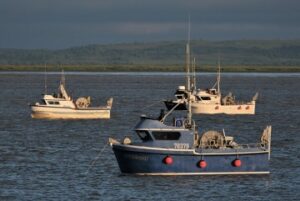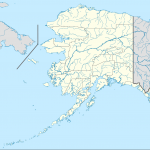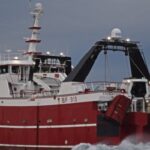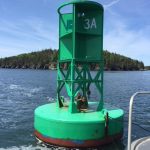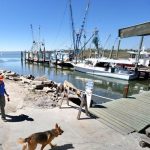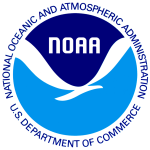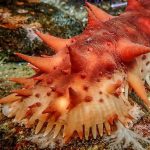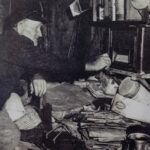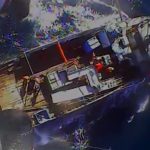Press Release – Western Pacific Regional Fishery Management Council Recommend Reducing 2017 Catch Limits for Three Species
 Federal Fishery Managers Recommend Reducing 2017 Catch Limits for Three Species
Federal Fishery Managers Recommend Reducing 2017 Catch Limits for Three Species
HONOLULU (21 June 2017) The Western Pacific Regional Fishery Management Council today concluded the second of its three-day meeting in Honolulu with a recommendation that the annual catch limits (ACLs) for three species in the US Pacific Islands be reduced in 2017. The reductions are recommended because the average commercial catches of these species have exceeded the ACLs over the past three years or more.
For Guam jacks, the recommended 2017 ACL is 23,894 pounds. The original ACL for this species was 29,300 pounds. The average catch the past three years was 26,607 pounds.
For the Hawai’i crustaceans (primarily white crab) and mollusks (primarily day octopus), the recommended 2017 ACLs are 31,994 pounds and 27,974 pounds, respectively. The original ACLs were 35,700 pounds and 33,500 pounds, respectively. The recent three-year averages are 28,140 and 38,889 pounds.
The ACLs of two other species have also been exceeded, but the Council recommended against adjusting their ACLs at this time. The American Samoa rabbitfish recent three-year average catch of 435 pounds is attributed mostly to improvements in data collection. The American Samoa Department of Marine and Wildlife Resources (DMWR) implemented an evening shift of the creel surveys better capture the night-time, shore-based spear fishery.
The 21 students of the 2017 Hawai’i Marine Resources and Management High School Summer Course attended the Council meeting to thank the Council for its continued support of the program.
The Council also noted that the 2016 catch estimate may have an estimation error. Based on this, the Council recommended that the ACL remain at 163 pounds and requested that the National Marine Fisheries Service (NMFS) re-examine the 2016 catch estimate for potential estimation error.
The CNMI slipper lobster recent three-year average of catch of 101 pounds exceeds the 2016 ACL of 60 pounds. The slipper lobster fishery is tracked through commercial receipt books. Data submitted through this system has increased dramatically. In 2016, 59 invoices and 19 fishermen reported sale of slipper lobsters. The amounts in previous years were zero.
To further improve catch reporting, the Council requested that the Hawai’i Division of Aquatic Resources, Commonwealth of the Northern Mariana Islands (CNMI) Department of Lands and Natural Resources, Guam Department of Agriculture and American Samoa DMWR consider licensing and reporting requirements for fishers who harvest ACL species and support the management of these ACLs with the Council. All of these local agencies are represented on the Council. In Hawai’i, co-management already occurs with the main Hawaiian Islands bottomfish fishery. When the ACL is reached, the fishery is closed in both federal and state waters.
The Council agreed to also work with the CNMI Division of Fish and Wildlife in finalizing the rules and regulation package to support the public law on mand
atory reporting and to explore, in collaborate with local fishery management agencies, options for privatizing the data collection program in the territories.
Among other actions taken by the Council are the following:
Tropical Tuna Management: Recommended that NMFS incorporate the following elements in the US government position:
a) PURSE SEINE: i) Flag-based fish aggregation device (FAD) set limits with potential for transferability; ii) Prohibit dawn sets after FAD set limit reached; iii) Prohibit the deployment of FADs by tender vessels; iv) Require non-entangling FADs and work towards biodegradable designs; and v) Promote evaluation that examines purse seine vessel bigeye limits.
b) LONGLINE: i) Flag-based bigeye longline catch limits with potential transferability and limits delineated spatially (e.g., 20° N – 20° S); ii) Ban at-sea longline transshipment and support increased port sampling and monitoring capacity.
c) OTHER FISHERIES: i) Establish flag-based catch limits for other fisheries including Indonesia and Philippines; and ii) Continued data improvement programs
American Samoa Longline Limited Entry Program: Recommended the following preliminary preferred modifications, among others:
a) Replace the four vessel classes with two, where Class A and B vessels would be considered “small” and Class C and D vessels would be considered “large”;
b) Restrict permit ownership to US citizens and nationals only and eliminate criteria for having documented history of participation to be eligible for owning a permit, but maintain the priority ranking system based on earliest documented history of fishing participation in vessel class size if there is competition between two or more applicants for a permit;
c) Require that permits can only be transferred to US citizens or nationals, and eliminate the requirement for documented participation in American Samoa longline fishery to receive permit transfer;
d) Reduce the “small” vessel class minimum harvest requirement to 500 pounds of managed pelagic species within a three-year period but maintain the existing 5,000 pounds harvest for the “large” vessel class; and
e) Require that the entire minimum harvest amounts for the respective vessel classes to be landed in American Samoa within the three-year permit period but that the minimum harvests not be required to be caught within the EEZ around American Samoa.
A regulatory amendment document for final action will be reviewed by the Council at its 171st meeting this October in American Samoa.
American Samoa Large Vessel Prohibited Area: In light of a court decision that requires the Council and NMFS to protect and preserve American Samoa cultural fishing, the Council will consider at its 171st meeting in American Samoa a definition of cultural fishing that recognizes that Pacific Island cultures and fishing are inextricably linked, and that cultural fishing in American Samoan is grounded in cultural values embodied in Fa’a Samoa and Samoan practices such as tautua (“service”). The Council will consult with the American Samoa government on the issue of American Samoa cultural fishing. The Council will consider a definition that takes into account the following:
Fishing conducted by community residents of American Samoa in association non-commercial and commercial fishing activities involving any gear type employed;
Fishing may include the use of traditional fishing gear as well as new technologies and materials;
Cultural fishing may include other relevant factors identified through public scoping and stakeholder participation.
American Samoa Shark Law: The Council requested that American Samoa DMWR move quickly to finalize the American Samoa shark law that would exempt the landing of sharks with fins attached by federally authorized fisheries managed under the Council’s Fishery Ecosystem Plans.
The Council has authority over fisheries seaward of the jurisdictions of Hawai’i, American Samoa, Guam, CNMI and all US waters around the US Pacific Remote Islands Areas. The Council meeting is open to the public and will continue tomorrow from 8:30 a.m. to 5 p.m. at the YWCA, Fuller Hall, 1040 Richards St.
For more information, go to www.wpcouncil.org, email [email protected] or phone (808) 522-8220.
Western Pacific Regional Fishery Management Council: Secretary of Commerce appointees from nominees selected by American Samoa, CNMI, Guam and Hawai`i governors:Edwin Ebisui Jr. (Hawaii) (chair); Michael Duenas, Guam Fishermen’s Cooperative Association (Guam) (vice chair); John Gourley, Micronesian Environmental Services (CNMI) (vice chair); Christinna Lutu-Sanchez, commercial fisherman (American Samoa); McGrew Rice, commercial and charter fisherman (Hawaii) (vice chair); Michael Goto, United Fishing Agency (Hawaii); Dean Sensui, film producer (Hawaii); Archie Soliai, StarKist (American Samoa). Designated state officials: Anthony Benavente, CNMI Department of Lands and Natural Resources; Suzanne Case, Hawai`i Department of Land & Natural Resources; Matt Sablan, Guam Department of Agriculture; Henry Sesepasra, American Samoa Department of Marine & Wildlife Resources. Designated federal officials (voting): Michael Tosatto, NMFS Pacific Islands Regional Office. Designated federal officials (non-voting): Matthew Brown, USFWS; Michael Brakke, US Department of State; RADM Vincent B. Atkins, USCG 14th District.
______________________________________________________________________________
A Council authorized by the Magnuson Fishery Conservation and Management Act of 1976
1164 Bishop St., Suite 1400, Honolulu, HI * Tel (808) 522-8220 * Fax (808) 522-8226 * www.wpcouncil.org

































